Abstract
Aquatic organisms can take up organic pollutants from their environment and subsequently excrete the pollutant or its biotransformation products (metabolites). Phase II (conjugation) biotransformation products are almost always less toxic than the unmetabolized organic pollutant. For many organic pollutants, the extent to which conjugates are formed is extremely important in determining the rate of excretion of the pollutant. This is because most conjugates (glycosides, sulfates, amino acid conjugates, mercapturic acids) are organic anions which are readily water-soluble and are rapidly excreted by fish (and probably higher invertebrates) by a combination of glomerular filtration and tubular transport. In this paper, each major conjugation pathway is discussed with respect to what is known about its occurrence in fish and aquatic invertebrates, both from in vivo and in vitro data. Although limited data are available, this paper also considers what is known about how each conjugation reaction affects the toxicity and potential for renal and biliary excretion of organic xenobiotic substrates.
Full text
PDF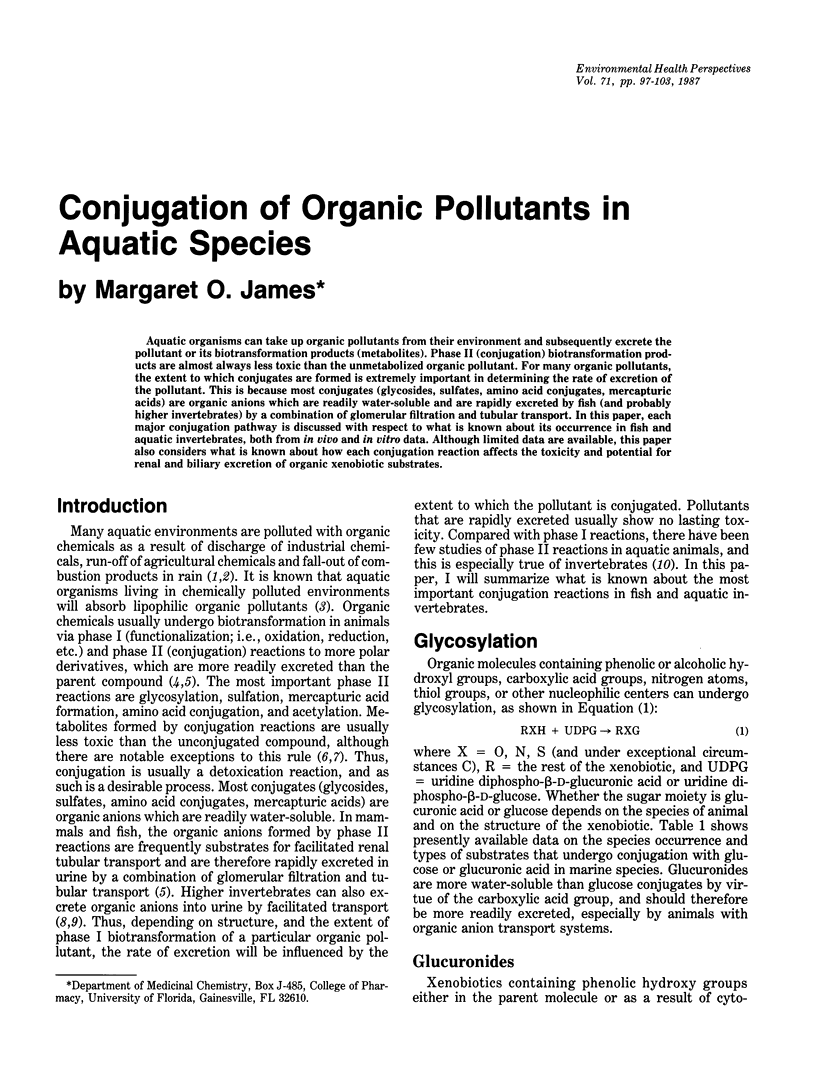

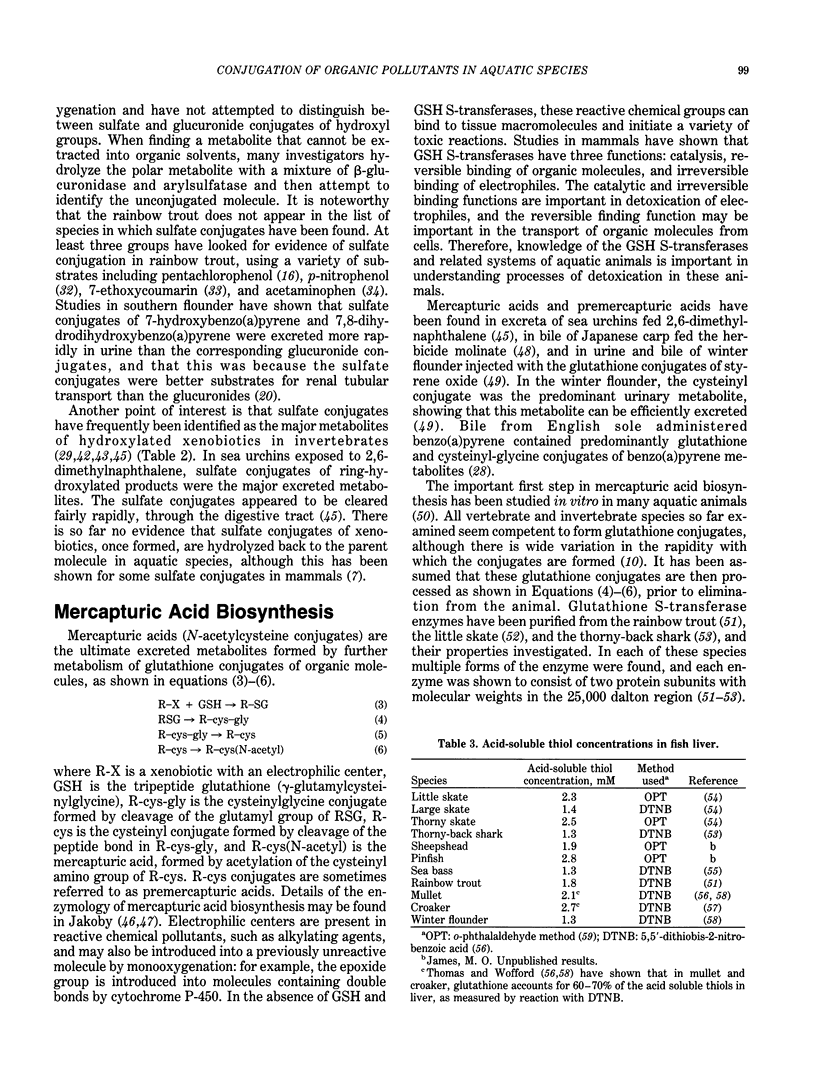

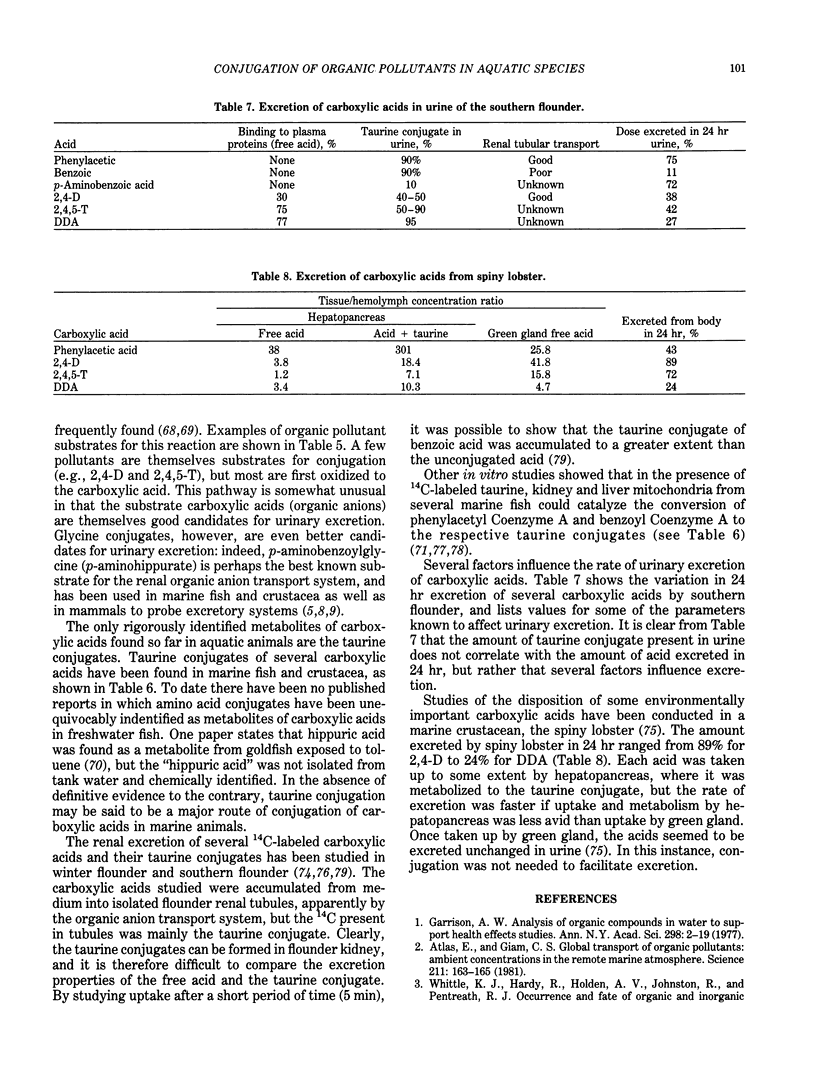
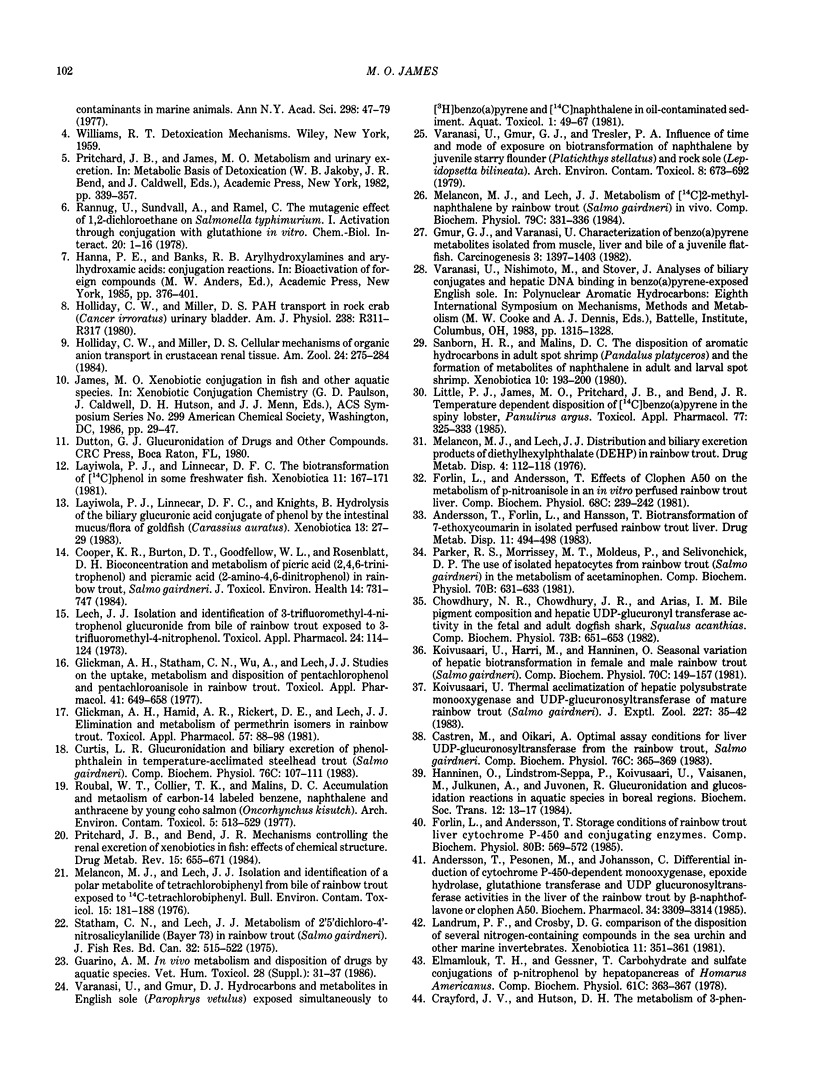
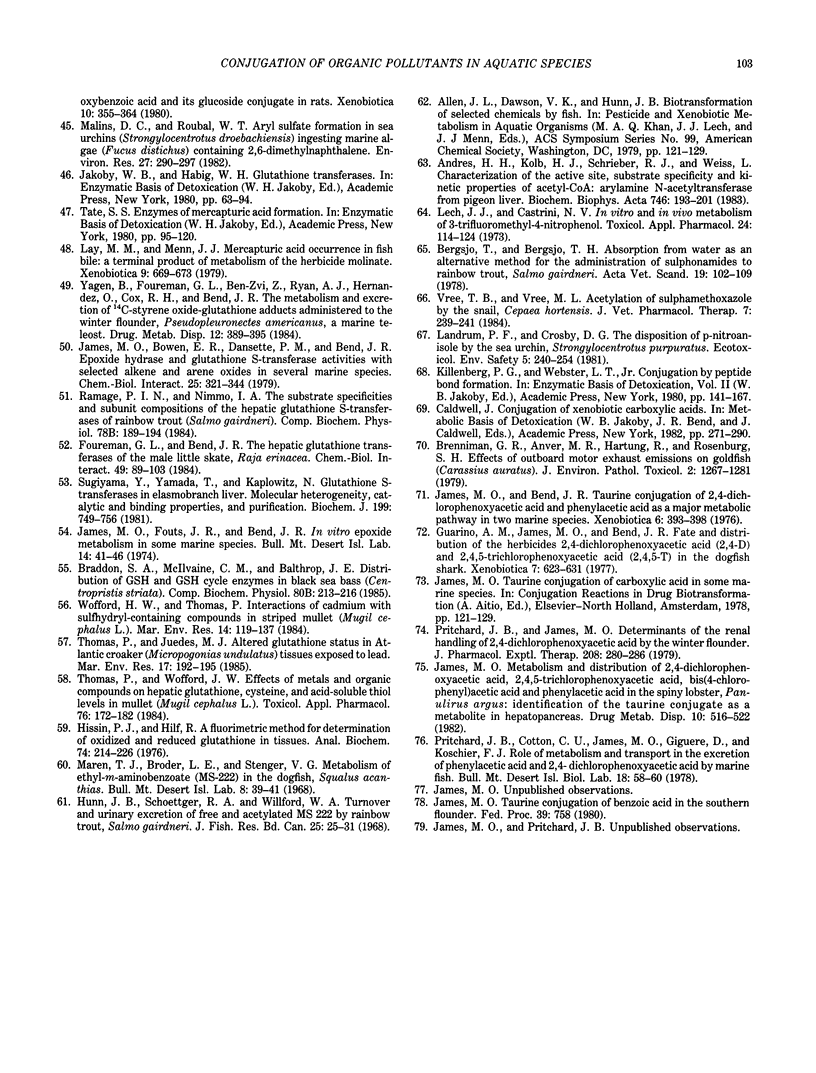
Selected References
These references are in PubMed. This may not be the complete list of references from this article.
- Andersson T., Förlin L., Hansson T. Biotransformation of 7-ethoxycoumarin in isolated perfused rainbow trout liver. Drug Metab Dispos. 1983 Sep-Oct;11(5):494–498. [PubMed] [Google Scholar]
- Andersson T., Pesonen M., Johansson C. Differential induction of cytochrome P-450-dependent monooxygenase, epoxide hydrolase, glutathione transferase and UDP glucuronosyl transferase activities in the liver of the rainbow trout by beta-naphthoflavone or Clophen A50. Biochem Pharmacol. 1985 Sep 15;34(18):3309–3314. doi: 10.1016/0006-2952(85)90351-x. [DOI] [PubMed] [Google Scholar]
- Andres H. H., Kolb H. J., Schreiber R. J., Weiss L. Characterization of the active site, substrate specificity and kinetic properties of acetyl-CoA:arylamine N-acetyltransferase from pigeon liver. Biochim Biophys Acta. 1983 Aug 16;746(3):193–201. doi: 10.1016/0167-4838(83)90074-2. [DOI] [PubMed] [Google Scholar]
- Atlas E., Giam C. S. Global transport of organic pollutants: ambient concentrations in the remote marine atmosphere. Science. 1981 Jan 9;211(4478):163–165. doi: 10.1126/science.211.4478.163. [DOI] [PubMed] [Google Scholar]
- Bergsjø T., Bergsjø T. H. Absorption from water as an alternative method for the administration of sulphonamides to rainbow trout, salmo gairdneri. The significance of the pKa value of the sulphonamides and the pH and salt content of the water. Acta Vet Scand. 1978;19(1):102–109. doi: 10.1186/BF03547646. [DOI] [PMC free article] [PubMed] [Google Scholar]
- Brenniman G. R., Anver M. R., Hartung R., Rosenberg S. H. Effects of outboard motor exhaust emissions on goldfish (Carassius auratus). J Environ Pathol Toxicol. 1979 Jul-Aug;2(6):1267–1281. [PubMed] [Google Scholar]
- Chowdhury N. R., Chowdhury J. R., Arias I. M. Bile pigment composition and hepatic UDP-glucuronyl transferase activity in the fetal and adult dogfish shark, Squalus acanthias. Comp Biochem Physiol B. 1982;73(3):651–653. doi: 10.1016/0305-0491(82)90091-8. [DOI] [PubMed] [Google Scholar]
- Cooper K. R., Burton D. T., Goodfellow W. L., Rosenblatt D. H. Bioconcentration and metabolism of picric acid (2,4,6-trinitrophenol) and picramic acid (2-amino-4,6-dinitrophenol) in rainbow trout Salmo gairdneri. J Toxicol Environ Health. 1984;14(5-6):731–747. doi: 10.1080/15287398409530622. [DOI] [PubMed] [Google Scholar]
- Crayford J. V., Hutson D. H. The metabolism of 3-phenoxybenzoic acid and its glucoside conjugate in rats. Xenobiotica. 1980 May;10(5):355–364. doi: 10.3109/00498258009033768. [DOI] [PubMed] [Google Scholar]
- Curtis L. R. Glucuronidation and biliary excretion of phenolphthalein in temperature-acclimated steelhead trout (Salmo gairdneri). Comp Biochem Physiol C. 1983;76(1):107–111. doi: 10.1016/0742-8413(83)90051-8. [DOI] [PubMed] [Google Scholar]
- Foureman G. L., Bend J. R. The hepatic glutathione transferases of the male little skate, Raja erinacea. Chem Biol Interact. 1984 Apr;49(1-2):89–103. doi: 10.1016/0009-2797(84)90054-1. [DOI] [PubMed] [Google Scholar]
- Förlin L., Andersson T. Effects of clophen A50 on the metabolism of paranitroanisole in an in vitro perfused rainbow trout liver. Comp Biochem Physiol C. 1981;68C(2):239–242. doi: 10.1016/0306-4492(81)90023-x. [DOI] [PubMed] [Google Scholar]
- Glickman A. H., Hamid A. A., Rickert D. E., Lech J. J. Elimination and metabolism of permethrin isomers in rainbow trout. Toxicol Appl Pharmacol. 1981 Jan;57(1):88–98. doi: 10.1016/0041-008x(81)90028-4. [DOI] [PubMed] [Google Scholar]
- Glickman A. H., Statham C. N., Wu A., Lech J. J. Studies on the uptake, metabolism, and disposition of pentachlorophenol and pentachloroanisole in rainbow trout. Toxicol Appl Pharmacol. 1977 Sep;41(3):649–658. doi: 10.1016/s0041-008x(77)80018-5. [DOI] [PubMed] [Google Scholar]
- Gmur D. J., Varanasi U. Characterization of benzo[a]pyrene metabolites isolated from muscle, liver, and bile of a juvenile flatfish. Carcinogenesis. 1982;3(12):1397–1403. doi: 10.1093/carcin/3.12.1397. [DOI] [PubMed] [Google Scholar]
- Guarino A. M. In vivo metabolism and disposition of drugs by aquatic species. Vet Hum Toxicol. 1986;28 (Suppl 1):31–37. [PubMed] [Google Scholar]
- Guarino A. M., James M. O., Bend J. R. Fate and distribution of the herbicides 2,4-dichlor-phenoxyacetic acid (2,4-D) and 2,4,5-trichlorophenoxyacetic acid (2,4,5-T) in the dogfish shark. Xenobiotica. 1977 Oct;7(10):623–631. doi: 10.3109/00498257709038684. [DOI] [PubMed] [Google Scholar]
- Hissin P. J., Hilf R. A fluorometric method for determination of oxidized and reduced glutathione in tissues. Anal Biochem. 1976 Jul;74(1):214–226. doi: 10.1016/0003-2697(76)90326-2. [DOI] [PubMed] [Google Scholar]
- Holliday C. W., Miller D. S. PAH transport in rock crab (Cancer irroratus) urinary bladder. Am J Physiol. 1980 May;238(5):R311–R317. doi: 10.1152/ajpregu.1980.238.5.R311. [DOI] [PubMed] [Google Scholar]
- Hänninen O., Lindström-Seppä P., Koivusaari U., Väisänen M., Julkunen A., Juvonen R. Glucuronidation and glucosidation reactions in aquatic species in boreal regions. Biochem Soc Trans. 1984 Feb;12(1):13–17. doi: 10.1042/bst0120013. [DOI] [PubMed] [Google Scholar]
- James M. O., Bend J. R. Taurine conjugation of 2,4-dichlorophenoxyacetic acid and phenylacetic acid in two marine species. Xenobiotica. 1976 Jul;6(7):393–398. doi: 10.3109/00498257609151651. [DOI] [PubMed] [Google Scholar]
- James M. O., Bowen E. R., Dansette P. M., Bend J. R. Epoxide hydrase and glutathione S-transferase activities with selected alkene and adrene oxides in several marine species. Chem Biol Interact. 1979 May;25(2-3):321–344. doi: 10.1016/0009-2797(79)90055-3. [DOI] [PubMed] [Google Scholar]
- James M. O. Disposition and taurine conjugation of 2,4-dichlorophenoxyacetic acid, 2,4,5-trichlorophenoxyacetic acid, bis(4-chlorophenyl)acetic acid, and phenylacetic acid in the spiny lobster, Panulirus argus. Drug Metab Dispos. 1982 Sep-Oct;10(5):516–522. [PubMed] [Google Scholar]
- Koivusaari U. Thermal acclimatization of hepatic polysubstrate monooxygenase and UDP-glucuronosyltransferase of mature rainbow trout (Salmo gairdneri). J Exp Zool. 1983 Jul;227(1):35–42. doi: 10.1002/jez.1402270106. [DOI] [PubMed] [Google Scholar]
- Landrum P. F., Crosby D. G. Comparison of the disposition of several nitrogen-containing compounds in the sea urchin and other marine invertebrates. Xenobiotica. 1981 May;11(5):351–361. doi: 10.3109/00498258109045314. [DOI] [PubMed] [Google Scholar]
- Landrum P. F., Crosby D. G. The disposition of p-nitroanisole by the sea urchin, Strongylocentrotus purpuratus. II. Biotransformation and bioconcentration. Ecotoxicol Environ Saf. 1981 Jun;5(2):240–254. doi: 10.1016/0147-6513(81)90038-5. [DOI] [PubMed] [Google Scholar]
- Lay M. M., Menn J. J. Mercapturic acid occurrence in fish bile. A terminal product of metabolism of the herbicide molinate. Xenobiotica. 1979 Nov;9(11):669–673. doi: 10.3109/00498257909042334. [DOI] [PubMed] [Google Scholar]
- Layiwola P. J., Linnecar D. F., Knights B. Hydrolysis of the biliary glucuronic acid conjugate of phenol by the intestinal mucus/flora of goldfish (Carassius auratus). Xenobiotica. 1983 Jan;13(1):27–29. doi: 10.3109/00498258309052211. [DOI] [PubMed] [Google Scholar]
- Layiwola P. J., Linnecar D. F. The biotransformation of [14C]phenol in some freshwater fish. Xenobiotica. 1981 Mar;11(3):167–171. doi: 10.3109/00498258109045288. [DOI] [PubMed] [Google Scholar]
- Lech J. J. Isolation and identification of 3-trifluoromethyl-4-nitrophenyl glucuronide from bile of rainbow trout exposed to 3-trifluoromethyl-4-nitrophenol. Toxicol Appl Pharmacol. 1973 Jan;24(1):114–124. doi: 10.1016/0041-008x(73)90186-5. [DOI] [PubMed] [Google Scholar]
- Lech J. J. Isolation and identification of 3-trifluoromethyl-4-nitrophenyl glucuronide from bile of rainbow trout exposed to 3-trifluoromethyl-4-nitrophenol. Toxicol Appl Pharmacol. 1973 Jan;24(1):114–124. doi: 10.1016/0041-008x(73)90186-5. [DOI] [PubMed] [Google Scholar]
- Little P. J., James M. O., Pritchard J. B., Bend J. R. Temperature-dependent disposition of [14C]benzo(a)pyrene in the spiny lobster, Panulirus argus. Toxicol Appl Pharmacol. 1985 Feb;77(2):325–333. doi: 10.1016/0041-008x(85)90332-1. [DOI] [PubMed] [Google Scholar]
- Malins D. C., Roubal W. T. Aryl sulfate formation in sea urchins (Strongylocentrotus droebachiensis) ingesting marine algae (Fucus distichus) containing 2,6-dimethylnaphthalene. Environ Res. 1982 Apr;27(2):290–297. doi: 10.1016/0013-9351(82)90084-6. [DOI] [PubMed] [Google Scholar]
- Melancon M. J., Jr, Lech J. J. Distribution and biliary excretion products of di-2-ethylhexyl phthalate in rainbow trout. Drug Metab Dispos. 1976 Mar-Apr;4(2):112–118. [PubMed] [Google Scholar]
- Melancon M. J., Jr, Lech J. J. Isolation and identification of a polar metabolite of tetrachlorobiphenyl from bile of rainbow trout exposed to 14C-tetrachlorobiphenyl. Bull Environ Contam Toxicol. 1976 Feb;15(2):181–188. doi: 10.1007/BF01685158. [DOI] [PubMed] [Google Scholar]
- Melancon M. J., Lech J. J. Metabolism of [14C]2-methylnaphthalene by rainbow trout (Salmo gairdneri) in vivo. Comp Biochem Physiol C. 1984;79(2):331–336. doi: 10.1016/0742-8413(84)90210-x. [DOI] [PubMed] [Google Scholar]
- Pritchard J. B., Bend J. R. Mechanism controlling the renal excretion of xenobiotics in fish: effects of chemical structure. Drug Metab Rev. 1984;15(4):655–671. doi: 10.3109/03602538409041075. [DOI] [PubMed] [Google Scholar]
- Pritchard J. B., James M. O. Determinants of the renal handling of 2, 4-dichlorophenoxyacetic acid by winter flounder. J Pharmacol Exp Ther. 1979 Feb;208(2):280–286. [PubMed] [Google Scholar]
- Ramage P. I., Nimmo I. A. The substrate specificities and subunit compositions of the hepatic glutathione S-transferases of rainbow trout (Salmo gairdneri). Comp Biochem Physiol B. 1984;78(1):189–194. doi: 10.1016/0305-0491(84)90166-4. [DOI] [PubMed] [Google Scholar]
- Roubal W. T., Collier T. K., Malins D. C. Accumulation and metabolism of carbon-14 labeled benzene, naphthalene, and anthracene by young coho salmon (Oncorhynchus kisutch). Arch Environ Contam Toxicol. 1977;5(4):513–529. doi: 10.1007/BF02220929. [DOI] [PubMed] [Google Scholar]
- Sanborn H. R., Malins D. C. The disposition of aromatic hydrocarbons in adult spot shrimp (Pandalus platyceros) and the formation of metabolites of naphthalene in adult and larval spot shrimp. Xenobiotica. 1980 Mar;10(3):193–200. doi: 10.3109/00498258009033745. [DOI] [PubMed] [Google Scholar]
- Sugiyama Y., Yamada T., Kaplowitz N. Glutathione S-transferases in elasmobranch liver. Molecular heterogeneity, catalytic and binding properties, and purification. Biochem J. 1981 Dec 1;199(3):749–756. doi: 10.1042/bj1990749. [DOI] [PMC free article] [PubMed] [Google Scholar]
- Thomas P., Wofford H. W. Effects of metals and organic compounds on hepatic glutathione, cysteine, and acid-soluble thiol levels in mullet (Mugil cephalus L.). Toxicol Appl Pharmacol. 1984 Oct;76(1):172–182. doi: 10.1016/0041-008x(84)90040-1. [DOI] [PubMed] [Google Scholar]
- Varanasi U., Gmur D. J., Treseler P. A. Influence of time and mode of exposure on biotransformation of naphthalene by juvenile starry flounder (Platichthys stellatus) and rock sole (Lepidopsetta bilineata). Arch Environ Contam Toxicol. 1979;8(6):673–692. doi: 10.1007/BF01054869. [DOI] [PubMed] [Google Scholar]
- Vree T. B., Vree M. L. Acetylation of sulphamethoxazole by the snail Cepaea hortensis. J Vet Pharmacol Ther. 1984 Sep;7(3):239–241. doi: 10.1111/j.1365-2885.1984.tb00906.x. [DOI] [PubMed] [Google Scholar]
- Whittle K. J., Hardy R., Holden A. V., Johnston R., Pentreath R. J. Occurrence and fate of organic and inorganic contaminants in marine animals. Ann N Y Acad Sci. 1978 Sep 29;298:47–79. doi: 10.1111/j.1749-6632.1977.tb19254.x. [DOI] [PubMed] [Google Scholar]
- Yagen B., Foureman G. L., Ben-Zvi Z., Ryan A. J., Hernandez O., Cox R. H., Bend J. R. The metabolism and excretion of 14C-styrene oxide-glutathione adducts administered to the winter flounder, Pseudopleuronectes americanus, a marine teleost. Identification of the corresponding S-cysteine derivatives as major urinary metabolites. Drug Metab Dispos. 1984 Jul-Aug;12(4):389–395. [PubMed] [Google Scholar]


